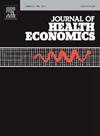处方权力和公平获得护理:来自加拿大安大略省药剂师的证据
IF 3.6
2区 经济学
Q1 ECONOMICS
引用次数: 0
摘要
允许药剂师直接治疗患者可能会增加获得医疗保健的公平机会并改善患者的治疗效果,但会引起对供应方道德风险或患者替代常规医生护理的担忧。我们研究了2023年加拿大安大略省允许药剂师为小病开处方的政策的影响。我们使用Advan人流量数据来衡量这一政策如何影响药房的访问量,并对非药房医疗设施的访问量产生溢出效应(Research, 2022)。允许药剂师开处方导致到药店的总访问量增加了16%,到其他提供者的访问量增加了3%。这些增长集中在物质匮乏的社区,非少数民族和非移民人口受益最多。我们使用政策作为外生变量来识别药房访问和交通到其他医疗设施之间的替代弹性。总体而言,药店客流量增加的20%会导致门诊护理的使用增加。药房流量是去医院和急诊科的替代品,因为病人可能依赖药剂师进行分诊,而不是紧急护理。本文章由计算机程序翻译,如有差异,请以英文原文为准。
Prescribing power and equitable access to care: Evidence from pharmacists in Ontario, Canada
Allowing pharmacists to directly treat patients may increase equitable access to healthcare and improve patient outcomes, but raises concerns about supply-side moral hazard or patient substitution away from regular physician-based care. We study the effects of a 2023 policy allowing pharmacists to prescribe for minor ailments in Ontario, Canada. We use Advan foot traffic data to measure how this policy affected visits to pharmacies and generated spillover effects on visits to non-pharmacy medical facilities (Research, 2022). Allowing pharmacists to prescribe led to a 16% increase in total visits to pharmacies and a 3% increase in visits to other providers. These increases were concentrated in materially deprived neighborhoods and benefited non-minority, non-immigrant populations the most. We use the policy as exogenous variation to identify substitution elasticities between pharmacy visits and traffic to other medical facilities. Overall, 20% of the increase in traffic to pharmacies spills over into increased use of outpatient-based care. Pharmacy traffic is a substitute for visits to hospitals and emergency departments, potentially as patients rely on pharmacists for triaging rather than emergency care.
求助全文
通过发布文献求助,成功后即可免费获取论文全文。
去求助
来源期刊

Journal of Health Economics
医学-卫生保健
CiteScore
6.10
自引率
2.90%
发文量
96
审稿时长
49 days
期刊介绍:
This journal seeks articles related to the economics of health and medical care. Its scope will include the following topics:
Production and supply of health services;
Demand and utilization of health services;
Financing of health services;
Determinants of health, including investments in health and risky health behaviors;
Economic consequences of ill-health;
Behavioral models of demanders, suppliers and other health care agencies;
Evaluation of policy interventions that yield economic insights;
Efficiency and distributional aspects of health policy;
and such other topics as the Editors may deem appropriate.
 求助内容:
求助内容: 应助结果提醒方式:
应助结果提醒方式:


